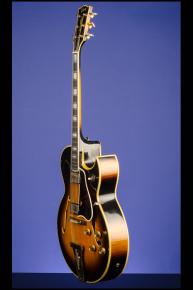A Fine 1968 Florentine (Sharp) Cutaway L-5 CES.
1968 Gibson L-5 CES (Eighth Model).
This 17-inch wide, just over 3 3/8 inch deep (at the rim) archtop weighs just 7.60 lbs. Two-piece book-matched, carved spruce top with a one-piece flamed maple back and flamed maple sides. Three-piece book-matched flamed maple neck with two mahogany strips, a nut width of just under 1 5/8 inches, a scale length of 25 1/2 inches and a very fast medium-thin profile. Multi-bound ebony fretboard with a small, graceful point at the end, 20 jumbo frets, inlaid pearl block position markers and black dot side markers. Nine-ply binding on the top of the guitar, five-ply binding on the back, and single-bound f-holes. Multi-bound headstock with inlaid pearl "Gibson" logo and pearl "L-5" flowerpot inlay. Three-layer black over white plastic bell-shaped truss-rod cover with "Custom" engraved in white, secured by two screws. Black-painted headstock rear face with widow's peak. Individual Kluson Sealfast tuners with bell-shaped metal buttons. Serial number "896490" stamped in blind on back of headstock. Two early Gibson patent-number humbucking pickups (with the "L" toolmarks on the feet still clearly visible) with rectangular black labels with "Pat No 2,737,842" on the underside and outputs of 7.33k and 7.84k. Black plastic pickup surrounds stamped on the underside "MR 491 / M-69 7" and "MR 490 / M-69 8". Four controls (two volume, two tone) on the lower treble bout, plus three-way pickup selector switch on the treble horn. Gold plastic bell-shaped knobs with metal tops. Original multi-bound tortoiseshell pickguard. Gibson Tune-O-Matic retainer bridge with nylon saddles on rosewood base and gold-plated flat plate tailpiece with engraved "L 5" and small hole at the bottom center (for allen wrench tension adjustment). All hardware gold-plated. Style number "L5-CESN" and serial number "896490" written in ink on the orange oval printed label inside the bass f-hole (no made in USA on label). The guitar has been expertly re-fretted with the correct gauge fretwire. There is a small amount of crystallization on the pickguard just by the bridge pickup - but the pickguard is quite sound and does not need any attention. There is some very light tarnishing to the gold-plated pickup covers. There are two small surface marks on the bass side of the top, a few very small surface marks on the treble edge of the top and an additional strap-button hole on the back just by the neck heel. With all that said, this prime example is in exceptionally fine (9.00) condition. Housed in it's original Gibson four-latch black 'Lifton' hardshell case with orange plush lining (9.00).
"The eighth model L-5CES (later 1960 through mid-1969), was equipped with the sharp Florentine body cutaway. It was bound at the pointed edge of the cutaway with celluloid material, much like that used to bind the top and back except that it was made of a single piece of plastic. These guitars were braced internally the same as the earliest L-5CES guitars, but they utilized a somewhat longer neck block because the cutaway was so deep and ran parallel to the neck for a longer distance. Otherwise, most appointments for the guitar remained the same as those in the L-5CES guitars from 1958 through 1960. The top-hat knobs of 1959-1960 were replaced in 1961 with the "dished-top" knobs with the metal insert in the tops. These knobs were utilized for tone and volume controls until about 1967, when the black top-hat knobs were introduced… The pickups in these guitars were initially PAF humbuckers, which were replaced by the patent-number humbuckers in approximately 1963. Just 601 'Florentine' cutaway L-5CES's were produced between 1960 and 1969.
"Timeless elegance. A jazz icon. The inspirational archtop guitar. These are just a few of the descriptions that fit Gibson’s L-5. Add to those a historical antecedent: the L-5 in various forms has been in constant production since late 1922, longer than any Martin, Gretsch, Epiphone, or National model... Originally conceived by acoustic engineer Lloyd Loar, the L-5 was the first guitar with design principles incorporated from carved instruments of the cello family. It represented a complete break from existing guitar design. Sporting simple appointments such as dot fingerboard inlays and a dark sunburst finish, the guitar was elegantly finished with a pearl 'flower pot' inlaid in the headstock below the Gibson logo, and a karat at the end of the fingerboard. The timing of the L-5’s introduction was nearly perfect since the guitar at that time was growing in popularity, but had yet to graduate from being just an instrument of vocal accompaniment to use in ensemble and orchestra settings…Certainly by the early ’40s the L-5 was a staple in jazz band and orchestral settings. At 17" across the lower bout, it was a perfectly sized instrument. Loud enough for orchestral use, but not so large and difficult to handle as Gibson’s Super 400 or the Epiphone Emperor, the L-5 was extremely popular among musicians in jazz, country and western, and large orchestras" (Eric C. Shoaf, "Gibson L-5: Loyd Loar's Timeless Masterpiece").












